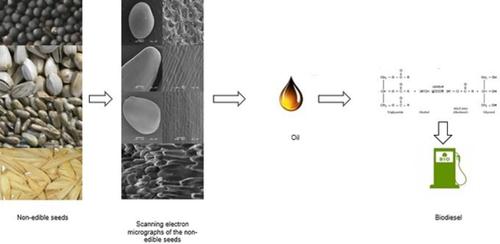当前位置:
X-MOL 学术
›
Microsc. Res. Tech.
›
论文详情
Our official English website, www.x-mol.net, welcomes your
feedback! (Note: you will need to create a separate account there.)
Implication, visualization, and characterization through scanning electron microscopy as a tool to identify nonedible oil seeds
Microscopy Research and Technique ( IF 2.0 ) Pub Date : 2020-09-20 , DOI: 10.1002/jemt.23595 Saman Ilyas Cheema 1 , Mushtaq Ahmad 1 , Riaz Ullah 2 , Ramzi A Mothana 2 , Omar M Noman 2 , Muhammad Zafar 1 , Shazia Sultana 1 , Ayesha Hameed 1 , Saeeda Naz 1 , Maryam Tanveer Akhtar 3
Microscopy Research and Technique ( IF 2.0 ) Pub Date : 2020-09-20 , DOI: 10.1002/jemt.23595 Saman Ilyas Cheema 1 , Mushtaq Ahmad 1 , Riaz Ullah 2 , Ramzi A Mothana 2 , Omar M Noman 2 , Muhammad Zafar 1 , Shazia Sultana 1 , Ayesha Hameed 1 , Saeeda Naz 1 , Maryam Tanveer Akhtar 3
Affiliation

|
Second‐generation biofuels prove to be a distinctive and renewable source of sustainable energy and cleaner environment. The current study focuses on the exploration and identification of four nonedible sources, that is, Brassica oleracea L., Carthamus oxyacantha M.Bieb., Carthamus tinctorius L., and Beaumontia grandiflora Wall., utilizing light microscopy (LM) and scanning electron microscopy (SEM) for studying the detailed micromorphological features of these seeds. LM revealed that size ranges from 3 to 20 mm. furthermore, a great variety of color is observed from pitch black to greenish gray and yellowish white to off white. Seeds ultrastructure study with the help of SEM revealed a great variety in shape, size, color, sculpturing and periclinal wall shape, and so on. Followed by the production of fatty acid methyl esters from a novel source, that is, seeds oil of Brassica oleracea L. (seed oil content 42.20%, FFA content 0.329 mg KOH/g) using triple metal impregnated montmorillonite clay catalyst (Cu‐Mg‐Zn‐Mmt). Catalyst was characterized using SEM–EDX, FT‐IR. Maximum yield of Brassica oleracea L. biodiesel (87%) was obtained at the conditions; 1:9 of oil to methanol ratio, 0.5 g of catalyst, 5 hr reaction time, and 90°C of temperature. Synthesized biodiesel was characterized by FT‐IR, GC–MS, and NMR. Fuel properties of the Brassica oleracea L. FAMES were determined and found in accordance with ASTM standards.
中文翻译:

通过扫描电子显微镜作为识别不可食用油籽的工具的意义、可视化和表征
事实证明,第二代生物燃料是可持续能源和清洁环境的独特且可再生的来源。目前的研究侧重于探索和四个非食用来源的识别,也就是说,甘蓝L.,红花oxyacantha M.Bieb,红花湖,和清明花属玉兰Wall.,利用光学显微镜 (LM) 和扫描电子显微镜 (SEM) 研究这些种子的详细微形态特征。LM 显示尺寸范围为 3 至 20 毫米。此外,还观察到从漆黑到灰绿色、黄白色到灰白色的多种颜色。借助 SEM 进行的种子超微结构研究揭示了种子在形状、大小、颜色、雕刻和周壁形状等方面的多样性。随后从一个新颖源生产的脂肪酸甲基酯,即,种子油甘蓝L.(种子油含量42.20%,游离脂肪酸含量0.329毫克KOH /克),使用三重金属浸渍的蒙脱石粘土催化剂(铜-镁-Zn-Mmt)。使用 SEM-EDX、FT-IR 表征催化剂。甘蓝的最大产量L. 生物柴油 (87%) 在该条件下获得;1:9 的油甲醇比,0.5 g 催化剂,5 小时反应时间和 90°C 温度。合成的生物柴油通过 FT-IR、GC-MS 和 NMR 进行表征。Brassica oleracea L. FAMES 的燃料特性是根据 ASTM 标准确定和发现的。
更新日期:2020-09-20
中文翻译:

通过扫描电子显微镜作为识别不可食用油籽的工具的意义、可视化和表征
事实证明,第二代生物燃料是可持续能源和清洁环境的独特且可再生的来源。目前的研究侧重于探索和四个非食用来源的识别,也就是说,甘蓝L.,红花oxyacantha M.Bieb,红花湖,和清明花属玉兰Wall.,利用光学显微镜 (LM) 和扫描电子显微镜 (SEM) 研究这些种子的详细微形态特征。LM 显示尺寸范围为 3 至 20 毫米。此外,还观察到从漆黑到灰绿色、黄白色到灰白色的多种颜色。借助 SEM 进行的种子超微结构研究揭示了种子在形状、大小、颜色、雕刻和周壁形状等方面的多样性。随后从一个新颖源生产的脂肪酸甲基酯,即,种子油甘蓝L.(种子油含量42.20%,游离脂肪酸含量0.329毫克KOH /克),使用三重金属浸渍的蒙脱石粘土催化剂(铜-镁-Zn-Mmt)。使用 SEM-EDX、FT-IR 表征催化剂。甘蓝的最大产量L. 生物柴油 (87%) 在该条件下获得;1:9 的油甲醇比,0.5 g 催化剂,5 小时反应时间和 90°C 温度。合成的生物柴油通过 FT-IR、GC-MS 和 NMR 进行表征。Brassica oleracea L. FAMES 的燃料特性是根据 ASTM 标准确定和发现的。









































 京公网安备 11010802027423号
京公网安备 11010802027423号